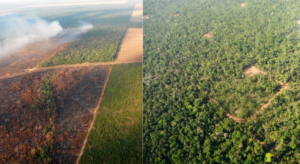Researchers found that degraded forests (burned and logged) do less photosynthesis during the
dry season, but recover productivity in about 4 years.
The Science
Large areas of the Amazon forest are being degraded through fires and logging. Degraded forests may suffer more water stress than intact forests during the dry season, but it remains an open question. A team of researchers used multiple remote sensing data to test this possibility. They used laser sensors on an aircraft to see changes in forest structure caused by degradation. They also used a satellite sensor that can see how much photosynthesis plants are doing. They compared both data sets to check how long it takes for forests to recover structure and photosynthesis after disturbance.
The Impact
The team found that fires cause much more damage to forests than logging. They also noticed that recently burned forests did less photosynthesis than intact forests. To their surprise, in just 4 years after disturbance, burned and logged forests were already doing as much photosynthesis as intact forests. However, the structure of burned forests remained very different from intact forests even after 14 years. This is important because each forest characteristic may take a very different time to recover from degradation.
Summary
Human cause disturbances that degrade tropical forests. Forest degradation from selective logging and fires alter forest structure and function. These changes also impact the ability of forests to uptake carbon. This study used airborne laser scanning data over the Amazon to investigate how forest structure varies across burned and logged forests of different ages since disturbance. In addition, the team used solar induced chlorophyl fluorescence (SIF) data from the TROPOMI mission. SIF is a proxy for photosynthesis, and the TROPOMI data provide information on how photosynthesis varies across seasons and across degraded and intact forests.
The researchers found that forest fires suffered the largest changes in the vertical distribution of foliage and canopy height compared to logged and intact forests. Moreover, SIF in recently burned forests were significantly lower than in intact forests. In contrast, within 4 years after the disturbance, SIF values were higher in regenerating forests than in intact forests. This was surprising because regenerating forests still had lower leaf area. These findings highlight that degraded forests recover photosynthesis rates faster than they recover forest structure. The results also indicate that degraded forests can accumulate large amounts of carbon during recovery from disturbance.

Contacts: Ekena Rangel Pinagé, College of Forestry, Oregon State University, rangelpe@oregonstate.edu
Marcos Longo, Lawrence Berkeley National Laboratory, mlongo@lbl.gov
Funding
This research was funded by the Australian Government Research Training Program Scholarship, the USDA Forest Service Pacific Northwest Research Station and International Programs, and by the Next Generation Ecosystem Experiments-Tropics, funded by the U.S. Department of Energy, Office of Science, Office of Biological and Environmental Research. The research carried out at the Jet Propulsion Laboratory, California Institute of Technology, was under a contract with the National Aeronautics and Space Administration.
Publications
Pinagé, E. R., D. M. Bell, M. Longo, S. Gao, M. Keller et al. “Forest structure and solar-induced
fluorescence across intact and degraded forests in the Amazon”. Remote Sensing of Environment
274, 112 998 (2022). [DOI: 10.1016/j.rse.2022.112998]